American Roads
American Roads > Early Roads • Road Construction
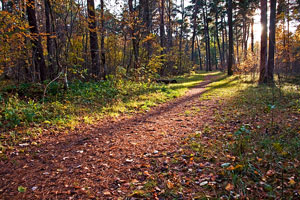 The history of roads in North America began unceremoniously with dirt paths that had been beaten down by deer and other
animals. Settlers often followed these paths, which turned into twisty and winding trails, sometimes following alongside
streams. Early roads were hewn out on foot and horseback, and eventually small towns began to spring up along crossroads
in the eastern colonies, with New England's greatest period of road building growth occurring from 1790 to 1840. By 1840,
there were more than 3,000 miles of "roads" in the United States of America, and the mid-1800s saw wagon trains going west
carrying pioneers. Early trading posts were established as commerce hubs for trading basic goods with the Native
Americans; over the course of time, stagecoaches became one of the first organized means of travel. Stage stops provided
a place where mail was received, and horses would be swapped out while passengers ate.
The history of roads in North America began unceremoniously with dirt paths that had been beaten down by deer and other
animals. Settlers often followed these paths, which turned into twisty and winding trails, sometimes following alongside
streams. Early roads were hewn out on foot and horseback, and eventually small towns began to spring up along crossroads
in the eastern colonies, with New England's greatest period of road building growth occurring from 1790 to 1840. By 1840,
there were more than 3,000 miles of "roads" in the United States of America, and the mid-1800s saw wagon trains going west
carrying pioneers. Early trading posts were established as commerce hubs for trading basic goods with the Native
Americans; over the course of time, stagecoaches became one of the first organized means of travel. Stage stops provided
a place where mail was received, and horses would be swapped out while passengers ate.
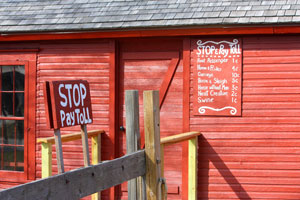 Early turnpikes were developed during the 1780s and 1790s, and were named after a device that was used to stop travelers
on English toll roads. These first turnpikes were operated by toll bridge corporations like Pennsylvania's Lancaster Turnpike,
which were required to build and maintain roads for a profit to shareholders. By 1800, two thirds of the country's seventy-two toll roads
were in New England. Although turnpikes became popular with investors, by the early 1800s they were proving to be not as
profitable as once hoped. Instead, turnpikes proved beneficial for raising real estate values and bringing new trade to merchants.
Early turnpikes were developed during the 1780s and 1790s, and were named after a device that was used to stop travelers
on English toll roads. These first turnpikes were operated by toll bridge corporations like Pennsylvania's Lancaster Turnpike,
which were required to build and maintain roads for a profit to shareholders. By 1800, two thirds of the country's seventy-two toll roads
were in New England. Although turnpikes became popular with investors, by the early 1800s they were proving to be not as
profitable as once hoped. Instead, turnpikes proved beneficial for raising real estate values and bringing new trade to merchants.
During the mid-19th century, transportation by stagecoach was gradually replaced by a system of railroads constructed on private land grants. This new system of transportation made long distance travel and transport of goods feasible and changed the progression of travel by road. Roads primarily became feeder systems for local industry to deliver products to faraway cities via the rail system.
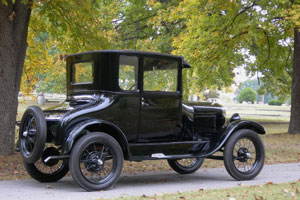 The automobile further changed the face of transportation, and the 1908 invention of the Ford Model T in particular made
individual travel easily affordable for the average family. This newfound means of transportation necessitated the
revamping of road infrastructure with paving, double width lanes, and the construction of gas stations at convenient
intervals. The government started establishing control using eminent domain, allowing it to purchase land standing in the
way of new road construction from private land owners without difficulty.
The automobile further changed the face of transportation, and the 1908 invention of the Ford Model T in particular made
individual travel easily affordable for the average family. This newfound means of transportation necessitated the
revamping of road infrastructure with paving, double width lanes, and the construction of gas stations at convenient
intervals. The government started establishing control using eminent domain, allowing it to purchase land standing in the
way of new road construction from private land owners without difficulty.
 In the 1950s, president Eisenhower initiated construction of the federal Interstate Highway System for the stated purpose of moving military hardware, such as tanks, around the country more
easily. This eventually led to our modern transportation system that is governed by a combination of federal and state
agencies. With increasingly heavy travel, overcrowding of our highway systems is again necessitating the need for new
solutions and more efficient public transportation methods such as intercity buses and mass transit systems.
In the 1950s, president Eisenhower initiated construction of the federal Interstate Highway System for the stated purpose of moving military hardware, such as tanks, around the country more
easily. This eventually led to our modern transportation system that is governed by a combination of federal and state
agencies. With increasingly heavy travel, overcrowding of our highway systems is again necessitating the need for new
solutions and more efficient public transportation methods such as intercity buses and mass transit systems.
 Two Young Women Viewing a Road Map
Two Young Women Viewing a Road Map
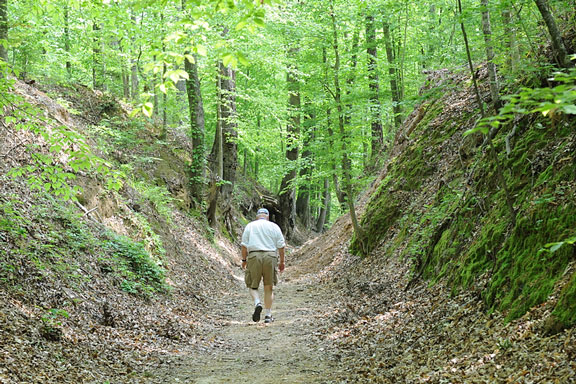 A man walks along the Old Natchez Trace -
A man walks along the Old Natchez Trace -an historic trail used by American Indians and early settlers.
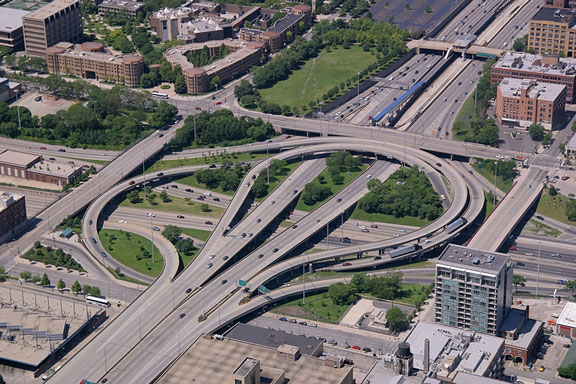 Modern Highway Interchange in Chicago
Modern Highway Interchange in Chicago
All rights reserved. About us.
For your convenience, certain links will open in new windows.